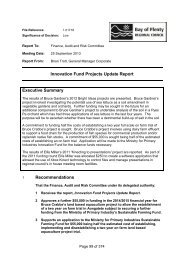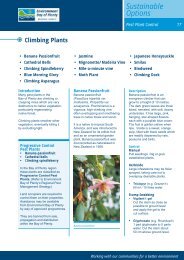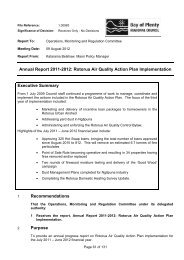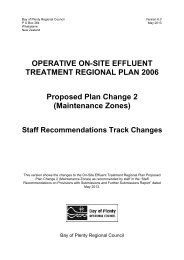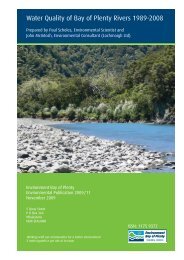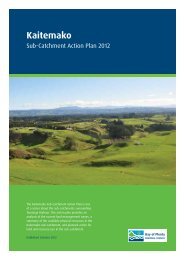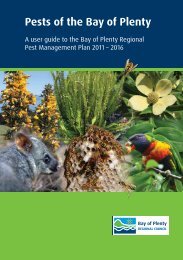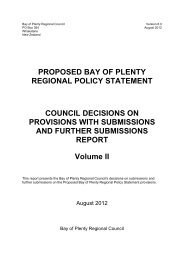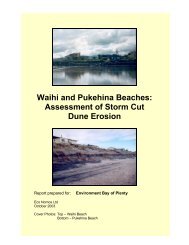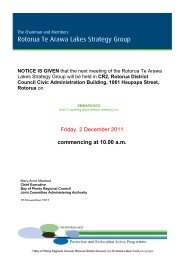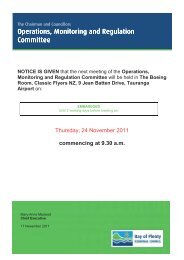Odour Threshold Investigation 2012 - Bay of Plenty Regional Council
Odour Threshold Investigation 2012 - Bay of Plenty Regional Council
Odour Threshold Investigation 2012 - Bay of Plenty Regional Council
You also want an ePaper? Increase the reach of your titles
YUMPU automatically turns print PDFs into web optimized ePapers that Google loves.
In relation to the second question <strong>of</strong> this investigation the groups were spatially different, with<br />
one consisting <strong>of</strong> panellists from Whakatāne and Tauranga (non-geothermal areas) and one<br />
group from Rotorua, where the panellists are frequently exposed to concentrations well<br />
above the international literature odour thresholds. Other basic characteristics <strong>of</strong> the groups<br />
showed that they were generally similar in pr<strong>of</strong>iles when it came to the age and sex <strong>of</strong> the<br />
panellists. The residence time for the Rotorua panellists was also recorded. This was<br />
compared with threshold values for this group. The results showed no relationship with<br />
residence time and average measured threshold.<br />
Several types <strong>of</strong> analysis <strong>of</strong> the grouped data showed that there was a statistically significant<br />
difference between the geometric mean odour threshold results for the two groups (1.1 µg/m 3<br />
for Rotorua and 0.5 µg/m 3 for Whakatāne). The difference was small, but in the direction we<br />
would expect (Rotorua higher than non-geothermal locale). The results also showed that the<br />
human response to odour is highly variable.<br />
The difference between the two groups is interesting in a purely theoretical sense. However,<br />
when taking into account – (i) the wide range <strong>of</strong> thresholds that have been published to date,<br />
(ii) inaccuracies in the methodologies used in these investigations, and (iii) the end use<br />
application <strong>of</strong> thresholds as a comparison point for modelled outputs, the difference shown<br />
between the two groups would be regarded as insignificant and largely treated as being the<br />
same for both. The analysis showed that the vast majority <strong>of</strong> the panellists were able to<br />
detect H 2 S at the 7 µg/m 3 level.<br />
In setting a guideline value it would be dependent on the receiving environments location, as<br />
both groups appear “equal” when it comes to detecting. Variations in odour response would<br />
be dependent on what is commonplace in their local environment. Communities that live in<br />
close proximity to existing or proposed developments or natural settings where H 2 S<br />
emissions are present are equally adept at detecting the odour at low concentrations, when<br />
compared with the Whakatāne group, but more <strong>of</strong>ten than not would be accepting <strong>of</strong> the<br />
odour pr<strong>of</strong>ile because <strong>of</strong> location.<br />
In regard to <strong>Council</strong> air quality policy, the findings <strong>of</strong> this investigation will be used in the<br />
upcoming <strong>Bay</strong> <strong>of</strong> <strong>Plenty</strong> <strong>Regional</strong> Air Plan review process.<br />
ii Environmental Publication <strong>2012</strong>/06–A review <strong>of</strong> odour properties <strong>of</strong> H 2 S <strong>Odour</strong> <strong>Threshold</strong> <strong>Investigation</strong> <strong>2012</strong>



